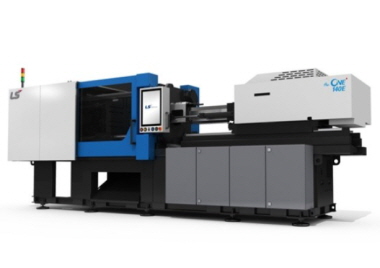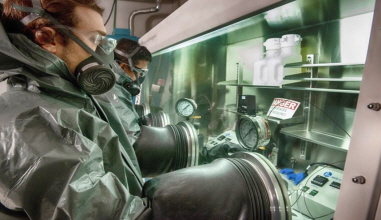How effective is your mold safety system?
MD of Sumitomo (SHI) Demag, Nigel Flowers, discusses tech and methods for preventing damage to expensive injection molding machine tooling
▲Sumitomo (SHI) Demag ActiveProtect from Sumitomo (SHI) Demag
Safety of the mold can be compromisedif components do not eject properly, if a foreign object enters the mold inproduction during the closing and opening sequence, and when too much clampforce is applied.
Very often, mold protection doesn’treceive the attention warranted. In part, this can be due to the complexity ofsetting up the system, which requires a certain skill level, particularly withregard to understanding clamp forces. Additionally, few injection moldingsuppliers offer active mold safety solutions that can sense and reactinstantaneously to an obstruction.
On top of safety
On these machines, thehigh-resolution sensor is located on the first link directly behind the movingclamping platen on the offside. The benefit of positioning the sensor close tothe point of force application is even the smallest tensile or compressionstrains are measured. It means that any condition that may result in the setmold safety force being exceeded is instantly addressed.
Nigel explains: “The signal producedby activeProtect is so accurate it can detect even the slightest change inforce patterns. Force values are converted in the transducer into a 0 to10-volt signal, which is immediately transmitted to the machine’s NC5 operatingcontrol system. At this point, the real values of closing force, piston speedand stroke are compared with the master calculations, enabling the machine toreact and stop before the mold faces touch. It’s like a chain reaction, withthe entire mold safety decision and response taking place in less than 10milliseconds.”
For added mold protection,activeProtect has now been extended to monitor the opening strokes. This helpsto ensure mechanical mold elements, for example unscrewing devices, areprotected from damage.
Other technology available
Additionally, users of the IntElectmachines can benefit from enhanced ejector control technology. Sumitomo (SHI)Demag’s latest advancement — Synchronized Ejector Operation — ensures thatcomponents are clear of the mold before it closes again. As well as preventing fallingparts being crushed, it helps to mitigate damage to expensive mold tools.
"In an ideal world the parts areejected with zero inertia and drop in a central line out of the mold space. Itisn’t so much of a challenge for users of hydraulic machines, as plastic partsflow out of the mold in a cascade-like waterfall. In all-electric machines,this constant stream can be difficult to replicate. That’s because when thetoggle clamp operates faster than the ejector mechanism, there’s less controlover how and where the molded components will fall,” explains Nigel.
Through the application of thistechnology, which enables synchronous operation of mold and ejector, theejector speed is adapted to the master mold speed. If the mold speed is sloweddown, the ejector is prohibited from moving closer than 20mm towards the mold.
Thermal imaging is another techniquethat can be used to control the optimum point to eject parts from the mold. Itcan also help to ensure that the mold is clear of components prior to moldclosing. Attached to the fixed platen on the machine, this infrared technologyuses heat to determine if parts have been ejected from the cavities.
The benefit for many is thermalimaging provides users of hybrid and hydraulic machines with a safety solution.“Compared to vision systems, thermal imaging is approximately a third of theinvestment cost. Additionally, thermal imaging can also be used to monitor thetemperature of parts, and document important production parameters,” notesNigel.
Help for hydraulics
For the large volume of molders stillusing hydraulic-only machinery, safety systems are conventional and morelimited. “Should an event happen within a mold in a hydraulic machine, theclosing phase will continue, albeit at a slower speed, pushing gently in thehope it will come to a standstill before any permanent damage from theobstruction is done to the mold,” emphasizes Nigel.
“Setting these safety parameters isreliant on machine operators having the skills and finesse to identify theregion in the closing stroke where the mold is most at risk,” adds Nigel.
Typically, this is just before thetwo mold faces touch. Operators then set a slower speed and force based on thehydraulic pressure level. Getting it wrong can lead to increased cycle timesand consequently lower output.
The passive nature of this safetysystem is its biggest drawback. It relies on an operative incrementallyconverting the toggle system characteristics and cylinder diameter to thehydraulic pressure to determine the most likely collision point. If, as theclamping proceeds, this pressure level is exceeded, the system pressure reliefvalve opens and the mold stops.
Additionally, the safety system hasto account for and overcome the mechanical resistance of the mold (cheeks andslides etc.). This often requires increased closing force, which again candamage the mold.
A slightly more sophisticated safetyoption was introduced with second generation machines. Featuring toggleclamping technology and more powerful control systems, machines were able tocalculate the mold position from the crosshead position by storing a model ofthe toggle system in the control. With this system, a consistent force isaccomplished by adjusting the pressure according to how close together the platensare.




















